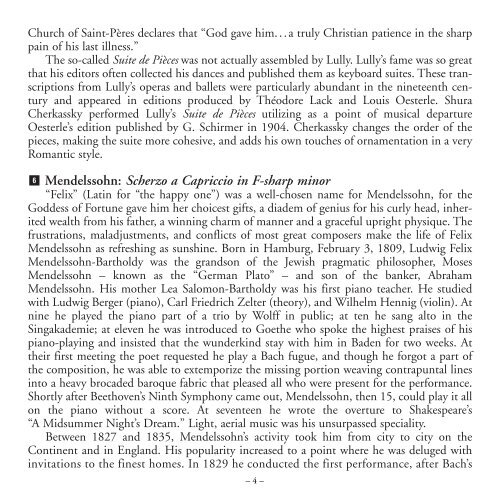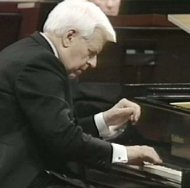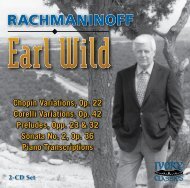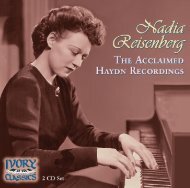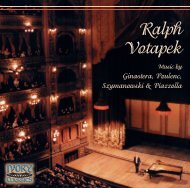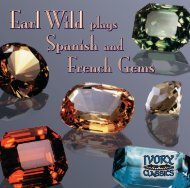70904 for PDF 11/05 - Ivory Classics
70904 for PDF 11/05 - Ivory Classics
70904 for PDF 11/05 - Ivory Classics
Create successful ePaper yourself
Turn your PDF publications into a flip-book with our unique Google optimized e-Paper software.
Church of Saint-Pères declares that “God gave him. . . a truly Christian patience in the sharp<br />
pain of his last illness.”<br />
The so-called Suite de Pièces was not actually assembled by Lully. Lully’s fame was so great<br />
that his editors often collected his dances and published them as keyboard suites. These transcriptions<br />
from Lully’s operas and ballets were particularly abundant in the nineteenth century<br />
and appeared in editions produced by Théodore Lack and Louis Oesterle. Shura<br />
Cherkassky per<strong>for</strong>med Lully’s Suite de Pièces utilizing as a point of musical departure<br />
Oesterle’s edition published by G. Schirmer in 1904. Cherkassky changes the order of the<br />
pieces, making the suite more cohesive, and adds his own touches of ornamentation in a very<br />
Romantic style.<br />
6 Mendelssohn: Scherzo a Capriccio in F-sharp minor<br />
“Felix” (Latin <strong>for</strong> “the happy one”) was a well-chosen name <strong>for</strong> Mendelssohn, <strong>for</strong> the<br />
Goddess of Fortune gave him her choicest gifts, a diadem of genius <strong>for</strong> his curly head, inherited<br />
wealth from his father, a winning charm of manner and a graceful upright physique. The<br />
frustrations, maladjustments, and conflicts of most great composers make the life of Felix<br />
Mendelssohn as refreshing as sunshine. Born in Hamburg, February 3, 1809, Ludwig Felix<br />
Mendelssohn-Bartholdy was the grandson of the Jewish pragmatic philosopher, Moses<br />
Mendelssohn – known as the “German Plato” – and son of the banker, Abraham<br />
Mendelssohn. His mother Lea Salomon-Bartholdy was his first piano teacher. He studied<br />
with Ludwig Berger (piano), Carl Friedrich Zelter (theory), and Wilhelm Hennig (violin). At<br />
nine he played the piano part of a trio by Wolff in public; at ten he sang alto in the<br />
Singakademie; at eleven he was introduced to Goethe who spoke the highest praises of his<br />
piano-playing and insisted that the wunderkind stay with him in Baden <strong>for</strong> two weeks. At<br />
their first meeting the poet requested he play a Bach fugue, and though he <strong>for</strong>got a part of<br />
the composition, he was able to extemporize the missing portion weaving contrapuntal lines<br />
into a heavy brocaded baroque fabric that pleased all who were present <strong>for</strong> the per<strong>for</strong>mance.<br />
Shortly after Beethoven’s Ninth Symphony came out, Mendelssohn, then 15, could play it all<br />
on the piano without a score. At seventeen he wrote the overture to Shakespeare’s<br />
“A Midsummer Night’s Dream.” Light, aerial music was his unsurpassed speciality.<br />
Between 1827 and 1835, Mendelssohn’s activity took him from city to city on the<br />
Continent and in England. His popularity increased to a point where he was deluged with<br />
invitations to the finest homes. In 1829 he conducted the first per<strong>for</strong>mance, after Bach’s<br />
– 4 –


